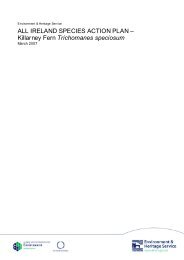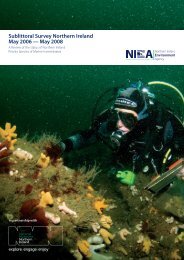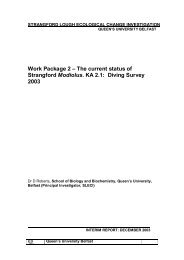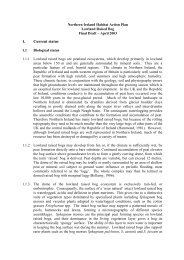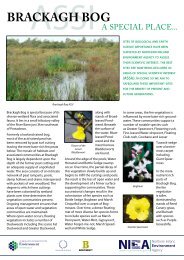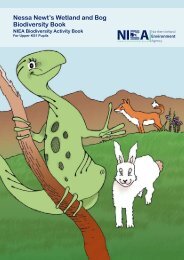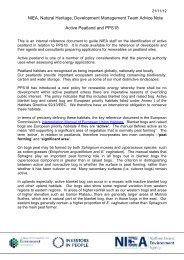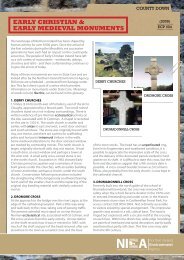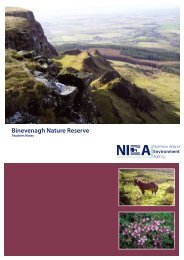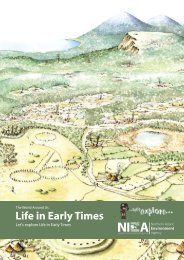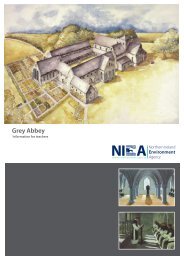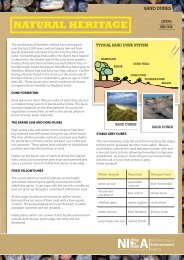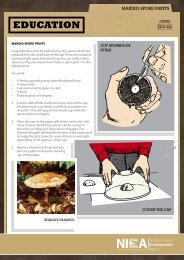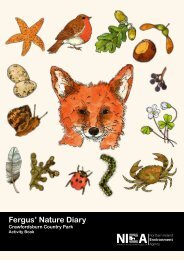Species Inventory for Northern Ireland Land and Freshwater Mollusca
Species Inventory for Northern Ireland Land and Freshwater Mollusca
Species Inventory for Northern Ireland Land and Freshwater Mollusca
Create successful ePaper yourself
Turn your PDF publications into a flip-book with our unique Google optimized e-Paper software.
Dr Roy Anderson<br />
1996<br />
<strong>Species</strong> <strong>Inventory</strong> <strong>for</strong> <strong>Northern</strong> <strong>Irel<strong>and</strong></strong><br />
<strong>L<strong>and</strong></strong> <strong>and</strong> <strong>Freshwater</strong> <strong>Mollusca</strong>
<strong>Species</strong> <strong>Inventory</strong> <strong>for</strong> <strong>Northern</strong> <strong>Irel<strong>and</strong></strong>: <strong>L<strong>and</strong></strong> <strong>and</strong> <strong>Freshwater</strong> <strong>Mollusca</strong><br />
Introduction<br />
This is one of a series of species inventories covering taxonomic or ecological groups of<br />
terrestrial <strong>and</strong> freshwater invertebrates of N. <strong>Irel<strong>and</strong></strong>. These reviews provide an inventory<br />
of the N. Irish fauna. These statements will be used as the local species account in the<br />
RECORDER database of CEDaR, the N. <strong>Irel<strong>and</strong></strong> Biological Records Centre.<br />
A major mapping exercise of the British Isles non-marine <strong>Mollusca</strong> was conducted in the<br />
nineteen-seventies by members of the Conchological Society. Progress <strong>and</strong> the main<br />
findings of the N. <strong>Irel<strong>and</strong></strong> part of the exercise were reported in two publications<br />
(Anderson 1977, 1983) <strong>and</strong> the overall mapping results in an Atlas published by the<br />
Society (Kerney 1976). A more recent publication by the Ulster Museum (Ross 1984)<br />
gives updated maps. A further updated Atlas is to be published by the Society in 1996.<br />
These publications summarise most of what is known of the molluscan fauna of N.<br />
<strong>Irel<strong>and</strong></strong>.<br />
Biogeography <strong>and</strong> ecology<br />
A total of 130 species of non-marine molluscs have been recorded in this area, of which<br />
9 were not recorded during the Conchological Society mapping exercise <strong>and</strong> have not<br />
been seen recently. Of these the majority are likely to be extinct or very rare: Hydrobia<br />
ventrosa, Myxas glutinosa, Truncatellina cylindrica, Vertigo pusilla, V. angustior,<br />
Testacella haliotidea, T. scutulum, Pisidium conventus, P. moitessierianum. Hydrobia<br />
ventrosa is a species of clear saltmarsh pools <strong>and</strong> may still survive in Strang<strong>for</strong>d or Larne<br />
Loughs <strong>for</strong> which there are old records. Myxas glutinosa has become very rare in Britain<br />
<strong>and</strong> although recorded recently from central <strong>Irel<strong>and</strong></strong> is likely to be extinct in the north<br />
because the habitats around Lough Neagh from which it was recorded are now eutrophic<br />
<strong>and</strong> unsuitable. Truncatellina cylindrica was found as a cabinet specimen in Ulster<br />
Museum by the Conchological Society Recorder Michael Kerney. The Groomsport<br />
locality is now untenable but if it is native to <strong>Irel<strong>and</strong></strong> it could occur at other Co. Down<br />
sites such as Murlough/Tyrella. Vertigo pusilla has been searched <strong>for</strong> at its old localities<br />
in Colin Glen <strong>and</strong> Whitepark Bay without success but it is possibly too early to rule out its<br />
re-discovery at some future date. The same holds <strong>for</strong> V. angustior which may survive in<br />
some of the extensive north coast dune systems in which sub-fossil shells have been<br />
found. However, it seems unlikely that the two Testacella species could have survived<br />
competition with the New Zeal<strong>and</strong> flatworm <strong>for</strong> now-scarce earthworms on which they<br />
feed, <strong>and</strong> present water conditions prevailing in the River Lagan make it unlikely that<br />
Pisidium moitessierianum will ever be refound there. This leaves P. conventus, a<br />
coldwater bivalve which may still survive in some of the deeper Fermanagh lakes. In<br />
summary, roughly 7% of the fauna has either disappeared or become very rare since the<br />
turn of the century. Despite this, only a few of the remaining species are in especially<br />
vulnerable or endangered categories <strong>and</strong> there have been many new discoveries,<br />
extensions of known range <strong>and</strong> additions to the fauna in the last twenty-five years. Most<br />
of these are reported in the RECORDER local accounts.<br />
Specialisms within the native fauna centre around the oceanicity of the climate. This<br />
clearly lends advantage to desiccation-vulnerable organisms <strong>and</strong> the slug species are<br />
particularly well represented. The European slugs are a polyphyletic group belonging to<br />
several families of disparate origins: Arionidae, Milacidae, Limacidae, Testacellidae.<br />
On mainl<strong>and</strong> north-west Europe about 29 species have been reliably reported from<br />
natural or semi-natural environments. In Britain <strong>and</strong> <strong>Irel<strong>and</strong></strong> the total reaches 30 species<br />
each. Two Irish species are unknown elsewhere in our part of Europe: Geomalacus<br />
maculosus (Kerry slug), Arion U1 (Ballywalter slug). Two British species are unrecorded<br />
1
<strong>for</strong> <strong>Irel<strong>and</strong></strong>: Deroceras agreste (which may eventually turn up) <strong>and</strong> Limax tenellus (an old<br />
wood, urwaldtiere, species). The N. <strong>Irel<strong>and</strong></strong> total is 26 as we lack Geomalacus<br />
maculosus, Arion lusitanicus, Milax rusticus (recently discovered in Cork) <strong>and</strong> Testacella<br />
maugei of the Irish species. The only slug species of conservation significance in <strong>Irel<strong>and</strong></strong><br />
are Geomalacus maculosus, the Testacella species <strong>and</strong> Milax rusticus. None of these<br />
are likely to occur now in N. <strong>Irel<strong>and</strong></strong>. The balance of the slug fauna is strongly oceanic<br />
with, by European st<strong>and</strong>ards, a remarkable variety of Arion species <strong>and</strong> abundance of<br />
individuals of relatively localised 'western' species such as Arion subfuscus <strong>and</strong> Limax<br />
marginatus.<br />
The non-slug <strong>Mollusca</strong> also has a well-developed oceanic facies <strong>and</strong> the species list<br />
includes Acicula fusca, Pyramidula rupestris, Leiostyla anglica, Lauria cylindracea,<br />
Spermodea lamellata <strong>and</strong> Zenobiella subrufescens. With the exception of Pyramidula<br />
<strong>and</strong> Lauria these are woodl<strong>and</strong> species <strong>and</strong> the maintenance of a wide network of seminatural<br />
woodl<strong>and</strong>s in glens <strong>and</strong> estates is necessary <strong>for</strong> their continued survival.<br />
Fortunately they all appear to adapt well to deciduous plantings <strong>and</strong> planted beech, not<br />
an Irish native, is particularly important <strong>for</strong> the survival of Spermodea lamellata. Despite<br />
the abundance of peatl<strong>and</strong>s in <strong>Irel<strong>and</strong></strong>, there are no molluscs specifically adapted to this<br />
environment <strong>and</strong> only one mollusc which is habitually calcifuge, Zonitoides excavatus.<br />
The latter is typical of lagg woodl<strong>and</strong> round the periphery rather than the exposed<br />
surface of bogs <strong>and</strong> occupies a wide range of woodl<strong>and</strong> types (except conifer) on acid<br />
substrata in the north <strong>and</strong> west of <strong>Irel<strong>and</strong></strong>. The freshwater fauna is relatively<br />
impoverished compared to that of the central plain, as also is the fen <strong>and</strong> swamp fauna.<br />
We lack some typical central species such as Theodoxus fluviatilis <strong>and</strong> Bithynia leachii<br />
among the freshwater species <strong>and</strong> the very localised Vertigo moulinsiana, V. geyeri <strong>and</strong><br />
Catinella arenaria among the wetl<strong>and</strong> species. This is more a consequence of<br />
topography <strong>and</strong> geology than climate <strong>and</strong> most of the central fauna extends at least as<br />
far as the Fermanagh lakel<strong>and</strong>. More species may well be recorded as the Fermanagh<br />
wetl<strong>and</strong>s become better explored. The xerophilic helicids which are such a<br />
conspicuous component of fauna in Mediterranean countries <strong>and</strong> dune habitats here are<br />
at their best development in south-central <strong>Irel<strong>and</strong></strong> <strong>and</strong> most are restricted to the coast in<br />
the north which is by comparison cold, exposed <strong>and</strong> base-deficient. Palaeoecological<br />
investigations indicate that the majority of these modern Irish helicids are recent<br />
introductions <strong>and</strong> only a minority, the Cepaea species <strong>and</strong> Helicella itala, are likely to<br />
be native. Conservation targets among the N. Irish <strong>Mollusca</strong> include the species listed at<br />
the beginning of this section. Other species are undoubtedly in decline, mostly as a<br />
result of arterial <strong>and</strong> other l<strong>and</strong> drainage, <strong>and</strong> the destruction of native scrub woodl<strong>and</strong>s.<br />
It is difficult to produce figures to substantiate potential losses but the 1970s mapping<br />
exercise provides a useful basis <strong>for</strong> future investigations into this question. There remain<br />
weaknesses in mapping coverage of some species. Some of the smaller <strong>and</strong> more<br />
elusive Vertiginidae, <strong>for</strong> instance, are often overlooked in mapping exercises <strong>and</strong> require<br />
more ef<strong>for</strong>t at specific sites to judge their status. The species of deeper freshwaters are<br />
also under-recorded because boats <strong>and</strong> dredges have only very rarely been used <strong>for</strong><br />
survey purposes in N. <strong>Irel<strong>and</strong></strong>. The continued occurrence of Pisidium henslowanum in L.<br />
Neagh <strong>and</strong> of P. conventus in Fermanagh, is uncertain <strong>and</strong> will only be resolved by this<br />
type of investigation. The Anodonta spp. are under-recorded throughout <strong>Irel<strong>and</strong></strong> <strong>for</strong><br />
similar reasons.<br />
The RECORDER Local <strong>Species</strong> Accounts given below supply more specific in<strong>for</strong>mation<br />
on the fauna. Those using RECORDER should note that Limax valentianus <strong>and</strong> Arion<br />
U1 are not currently on the programme. Limax valentianus records will be added shortly<br />
<strong>and</strong> the inclusion of Arion U1 must await its description in the scientific literature.<br />
2
SPECIES ACCOUNTS<br />
The writing of local species accounts in the present exercise serves to define current<br />
knowledge as a prelude to designation of species within RDB classes. The following<br />
accounts have been arranged in systematic order. For each species the number of sites<br />
at which it has been recorded since 1970 is denoted by a letter on the first line of each<br />
account according to the following categories:<br />
A: 1 site; B: 2-5; C 6-20; D: 21-50; E: 51-100; F: 100+; X: not recorded recently.<br />
Theodoxus fluviatilis (Linnaeus,1758) X<br />
Widely distributed in central <strong>Irel<strong>and</strong></strong> in slow-moving water or on lakeshores. It is recorded<br />
as far north-west as Glenade Lough, Sligo but not in Fermanagh (Kerney 1968). May<br />
possibly have been overlooked <strong>and</strong> could occur on lakeshores or in sluggish rivers in<br />
south Fermanagh.<br />
Valvata cristata Müller,1774 C<br />
Mainly recorded from the Lough Neagh Basin, from Co. Down, south Tyrone, Armagh<br />
<strong>and</strong> Fermanagh in N. <strong>Irel<strong>and</strong></strong> i.e. with a southerly distribution. Inhabits clear, weedy<br />
habitats of small size <strong>and</strong> nearly stagnant water such as weedy field drains, drumlin lakes<br />
<strong>and</strong> pools in interdrumlin bog.<br />
Valvata piscinalis (Müller,1774) D<br />
Ubiquitous in slow-flowing, weed-free water to 5 considerable depths in lakes <strong>and</strong> rivers.<br />
An important constituent of the diet of wintering wildfowl on Lough Neagh. Like related<br />
species, not usually in acid water, <strong>and</strong> rare or absent from much of the north <strong>and</strong> west,<br />
but unlike V. cristata, recorded from mid Antrim (Maine River System etc.).<br />
Hydrobia ventrosa (Montagu,1803) X<br />
There are old records <strong>for</strong> Magheramorne (R J Welch, 1898) <strong>and</strong> Glynn, Larne Lough (J N<br />
Milne, 1905), Strang<strong>for</strong>d Lough at Mountstewart (C H Waddell, 1912) <strong>and</strong> Killough<br />
Harbour (R J Welch/A W Stelfox, 1909) but this species has not been recorded since the<br />
latest date (1912). It is quite probably extant in some or all of these sites.<br />
Hydrobia ulvae (Pennant,1777) D<br />
Confined to partially saline coastal lagoons <strong>and</strong> estuaries but will tolerate high salinities<br />
in sheltered localities such as upper Belfast Lough. Fairly tolerant of organic pollution<br />
<strong>and</strong> an important item of diet <strong>for</strong> overwintering waders. Abundant in fine muds through<br />
to silty s<strong>and</strong> from EHWST to LWNT, burrowing just beneath the surface.<br />
Potamopyrgus antipodarum (Gray,1843) F<br />
[= jenkinsi (Smith,1889)]<br />
A naturalised New Zeal<strong>and</strong> species which invaded Irish freshwaters about the turn of the<br />
nineteenth century. Now abundant <strong>and</strong> widespread in clear streams, especially those<br />
which flow into the sea <strong>and</strong> some larger, richer lake systems.<br />
Bithynia tentaculata (Linnaeus,1758) D<br />
Like most other species which prefer hard water or larger water bodies this is confined to<br />
the south of N. <strong>Irel<strong>and</strong></strong>, but extends along the Bann from Lough Neagh to its estuary on<br />
the north coast. Abundant in Lough Neagh where it <strong>for</strong>ms a sizeable part of the diet of<br />
winter-visiting, diving ducks.<br />
Acicula fusca (Montagu, 1803) C<br />
Very widespread in <strong>Irel<strong>and</strong></strong> but never found in numbers <strong>and</strong> very local. Usually in soil or<br />
leaf litter in shaded, cool environments, often where base-rich strata outcrop. Most N.<br />
<strong>Irel<strong>and</strong></strong> records are <strong>for</strong> old woodl<strong>and</strong> or scrub on outcropping chalk, basalt or limestone.<br />
3
It is evidently less rare near the coast <strong>and</strong> there are a string of records <strong>for</strong> north Antrim<br />
<strong>and</strong> north Londonderry. It has been found, <strong>for</strong> instance, in moss on chalk cliffs at<br />
Ballycastle, <strong>and</strong> on chalk underlying basalt at Black Head, Antrim.<br />
Carychium minimum Müller, 1774 F<br />
Widespread <strong>and</strong> generally frequent in wetl<strong>and</strong>s <strong>and</strong> carr habitats, but easily overlooked.<br />
Not usually found at altitude or on base-deficient strata. Can occur with its congener, C.<br />
tridentatum, in wet woodl<strong>and</strong>, but this is rare.<br />
Carychium tridentatum (Risso, 1826) E<br />
Widespread in shaded habitats, usually in deep <strong>for</strong>est litter. Almost confined to sites<br />
where primaeval woodl<strong>and</strong> survived until supplemented by nineteenth century<br />
plantations. Like all the molluscan urwaldtiere in <strong>Irel<strong>and</strong></strong>, not in recently established or<br />
coniferous plantations.<br />
Ovatella myosotis (Draparnaud,1801) C<br />
Locally common at the roots of saltmarsh vegetation around the coast. Recorded from<br />
Strang<strong>for</strong>d Lough (widely), Dundrum Bay <strong>and</strong> the Foyle. Will also probably be found in<br />
Carling<strong>for</strong>d Lough.<br />
Leucophytia bidentata (Montagu,1808) B<br />
May occur with Ovatella myosotis in saltmarsh habitats, but not usually in heavy<br />
vegetation, preferring open muddy ground, under stones. A member also of the upper<br />
tidal crevice fauna <strong>and</strong> though under-recorded is likely to be common on slate rocks<br />
around the Co Down coast.<br />
Aplexa hypnorum (Linnaeus,1758) C<br />
Scattered <strong>and</strong> decreasing in frequency in temporary habitats such as seasonal<br />
floodwaters behind the shoreline of Lough Neagh. Mainly around Lough Neagh, along<br />
the Co. Down coast <strong>and</strong> in Fermanagh.<br />
Physa fontinalis (Linnaeus,1758) D<br />
Widespread <strong>and</strong> abundant in the Lough Neagh <strong>and</strong> Erne Basins, but recorded also from<br />
the north coast of Antrim, Rathlin Isl<strong>and</strong>, <strong>and</strong> the Foyle, Londonderry. Mainly found in<br />
clear, weedy <strong>and</strong> fairly stagnant waters such as canals, slow rivers <strong>and</strong> small lakes.<br />
Physa gyrina (Say, 1821) D<br />
This is a naturalised N American species which has escaped from aquaria into canals<br />
<strong>and</strong> similar habitats in central <strong>and</strong> southern Engl<strong>and</strong>. Despite a number of surveys of<br />
freshwater habitats in <strong>Irel<strong>and</strong></strong> since the mid-nineteen-sixties it has not previously been<br />
reported from natural habitats here. However, a specimen was taken on 28 September<br />
from a pond at the L. Neagh Discovery Centre at Ox<strong>for</strong>d Isl<strong>and</strong>. A search of the area on<br />
3 October 1995 produced large numbers both in the pond <strong>and</strong> in the open waters of L.<br />
Neagh at The Closet. It has subsequently been found throughout the Lough Neagh<br />
system <strong>and</strong> Lower Bann.<br />
Lymnaea truncatula (Müller,1774) F<br />
The main vector <strong>for</strong> the liver fluke, Fasciola hepatica, in N. <strong>Irel<strong>and</strong></strong>. Widespread <strong>and</strong><br />
abundant at all but higher altitudes, in wet pasture, by small streams <strong>and</strong> at the margins<br />
of a variety of wetl<strong>and</strong>s <strong>and</strong> bodies of fresh water.<br />
Lymnaea palustris (Müller,1774) D<br />
A lowl<strong>and</strong> species but extends to north Antrim <strong>and</strong> north Londonderry. Not recorded from<br />
south Londonderry <strong>and</strong> much of Tyrone. Mainly found at the (flooded) margins of<br />
medium to large water-bodies.<br />
4
Lymnaea stagnalis (Linnaeus,1758) D<br />
Not very common in N. <strong>Irel<strong>and</strong></strong> <strong>and</strong> with a Lough Neagh/Erne distribution. Prefers larger<br />
habitats <strong>and</strong> is relatively common around the shores of Lough Neagh. Mostly found in<br />
deeper <strong>and</strong> harder water than its congeners except the ubiquitous L. peregra.<br />
Lymnaea auricularia (Linnaeus,1758) D<br />
Very sparsely distributed in <strong>Irel<strong>and</strong></strong> but found in north Down, the Lagan Valley <strong>and</strong><br />
around Lough Neagh. The prevailing <strong>for</strong>m here (var. lagotis Schrank) is rather similar to<br />
larger <strong>for</strong>ms of L. peregra. Confined to larger or hard water habitats.<br />
Lymnaea peregra (Müller,1774) F<br />
Very variable in <strong>for</strong>m, the more extreme soft water <strong>for</strong>ms possess bubble shells <strong>and</strong><br />
evanescent spires <strong>and</strong> resemble Myxas glutinosa. This is the most commonly recorded<br />
freshwater mollusc in N. <strong>Irel<strong>and</strong></strong> <strong>and</strong> the British Isles, <strong>and</strong> found in a very wide range of<br />
trophic conditions, pH <strong>and</strong> turbidity.<br />
Myxas glutinosa (Müller, 1774) X<br />
Widely distributed in the canals of central <strong>Irel<strong>and</strong></strong> where it appears to have found a<br />
congenial habitat. Prefers solid bottoms in deeper rivers, lakes <strong>and</strong> canals but is rare <strong>and</strong><br />
erratic in its appearances. Recorded from the Bann at Portadown, Armagh (W A Greer,<br />
1900) <strong>and</strong> from Toome Canal, Antrim (R J Welch, 1900). Also from the Newry Canal. Not<br />
seen in N. <strong>Irel<strong>and</strong></strong> since 1900.<br />
Planorbis planorbis (Linnaeus,1758) C<br />
Common in temporary habitats or habitats of small size in central <strong>and</strong> southern <strong>Irel<strong>and</strong></strong><br />
but mysteriously localised in N. <strong>Irel<strong>and</strong></strong> <strong>and</strong> not reliably recorded outside the Lough<br />
Neagh Basin, Lagan Valley <strong>and</strong> vicinity of Belfast. It may be common in areas of winter<br />
flooding behind the shorelines of Lough Neagh.<br />
Planorbis carinatus Müller,1774 D<br />
Easily confused with P. planorbis in its typical <strong>for</strong>m (var. dubia Hartmann) in N. <strong>Irel<strong>and</strong></strong>,<br />
but found exclusively in larger water bodies such as the open water of canals, rivers <strong>and</strong><br />
lakes. Widespread <strong>and</strong> common in the Lough Neagh/Erne Basins.<br />
Anisus leucostoma (Millet,1813) D<br />
A species of small or temporary water-bodies, often found with Bathyomphalus contortus<br />
<strong>and</strong> Aplexa hypnorum. Widespread in the Lough Neagh Basin, coastal Co. Down, <strong>and</strong><br />
Fermanagh but very scattered elsewhere.<br />
Anisus vortex (Linnaeus,1758) C<br />
Until the nineteen-sixties restricted to the Erne Basin within N. <strong>Irel<strong>and</strong></strong>. A 'central' species<br />
in <strong>Irel<strong>and</strong></strong>, prefering hard water habitats or larger water-bodies. It was recorded in the<br />
River Lagan near Belfast in 1972 as a recent introduction <strong>and</strong> had spread as far<br />
upstream as Hilden, Lisburn by 1975 (Anderson, 1979). Its present distribution is<br />
unknown but it will probably continue to spread via the Lagan Canal in the direction of<br />
Lough Neagh.<br />
Bathyomphalus contortus (Linnaeus,1758) D<br />
A species of small or temporary water-bodies, drains <strong>and</strong> marshy or peaty pools.<br />
Widespread <strong>and</strong> fairly common but not recorded in most of central <strong>and</strong> north Tyrone or<br />
south Londonderry.<br />
Gyraulus laevis (Alder,1838) B<br />
Widely but very thinly scattered <strong>and</strong> mainly along the coast in N. <strong>Irel<strong>and</strong></strong>. Prefers hard or<br />
slightly saline water <strong>and</strong> is rarely found with more than one or two other species of<br />
5
molluscs. Recently recorded only from two sites in the Ards Peninsula, Down, <strong>and</strong> from a<br />
Lough Neagh marsh at Rea's Wood NNR.<br />
Gyraulus albus (Müller,1774) E<br />
The most widespread planorbid but infrequently seen alive as it inhabits deep, weedy<br />
water. Mainly in lakes <strong>and</strong> larger rivers in the south <strong>and</strong> east of N. <strong>Irel<strong>and</strong></strong>.<br />
Armiger crista (Linnaeus,1758) D<br />
A very small species <strong>and</strong> easily overlooked. Very widespread in clean, weedy conditions<br />
in still water habitats, although mainly recorded from sluggish streams, drains <strong>and</strong><br />
marshy pools. Not found in very acid waters.<br />
Hippeutis complanatus (Linnaeus,1758) C<br />
Mainly in the Lough Neagh/Erne catchments in N. <strong>Irel<strong>and</strong></strong> in hard water <strong>and</strong> prefers<br />
clear, weedy conditions. There are relatively few recent records <strong>and</strong> it appears to be<br />
generally scarce.<br />
Planorbarius corneus (Linnaeus,1758) D<br />
The large 'ramshorn' snail of aquarists. Not native to N. <strong>Irel<strong>and</strong></strong> but introduced to<br />
ornamental ponds in various locations in the last century <strong>and</strong> a half. Most of these<br />
introductions have died out but an introduction to the River Lagan (R J Welch, 1933)<br />
spread to Lough Neagh (Anderson 1977) it is now widespread in the Lough Neagh Basin<br />
<strong>and</strong> in Co. Down. Can survive in remarkably acidic conditions in drains including raised<br />
bog at Killycolpy on the shores of Lough Neagh where shells are fragile <strong>and</strong> decorticate.<br />
Ancylus fluviatilis Müller,1774 F<br />
Abundant in unpolluted running water of all kinds. Also on stones in the wave zone of<br />
larger lakes. Disappears with pollution by silage effluent etc. but gradually recolonises<br />
lost territory. A good indicator of the pollution status of small streams <strong>and</strong> rivers.<br />
Throughout N. <strong>Irel<strong>and</strong></strong>.<br />
Acroloxus lacustris (Linnaeus,1758) C<br />
Local in southern parts of N. <strong>Irel<strong>and</strong></strong>. Chiefly found in the Co. Down lakes, around Lough<br />
Neagh <strong>and</strong> in Fermanagh where it lives on the stems of tall marginal or submerged<br />
vegetation in still waters.<br />
Succinea oblonga Draparnaud, 1801 C<br />
Confined to five relatively small areas of <strong>Irel<strong>and</strong></strong> but not uncommon within these areas.<br />
A boreal relict <strong>and</strong> rare or very localised in most of the British Isles. In N. <strong>Irel<strong>and</strong></strong> there<br />
are two main areas: on the north-eastern shores of Lough Neagh between Cranfield<br />
Point <strong>and</strong> Rea's Wood NNR south of Antrim; <strong>and</strong> around the shores of Lower Lough<br />
Erne, extending northwards into south Donegal. The Lough Neagh <strong>for</strong>m is unusual in<br />
having a very thin, greenish shell with a low spire. On Lough Neagh the species inhabits<br />
open, s<strong>and</strong>y, gravelly or stony lakeshores, although sometimes under alder st<strong>and</strong>s. On<br />
Lough Erne the habitat is s<strong>and</strong>y or limestone pasture, on stone dykes <strong>and</strong> in quarries.<br />
Succinea putris (Linnaeus,1758) C<br />
Localised to the Lagan Valley, southern shores of Lough Neagh <strong>and</strong> Fermanagh, but<br />
much more widespread <strong>and</strong> common in southern <strong>Irel<strong>and</strong></strong>. Found in lush waterside<br />
vegetation which it crawls up, along riverbanks <strong>and</strong> lakeshores.<br />
Oxyloma pfeifferi (Rossmässler,1835) E<br />
The most widespread succineid (amber snail) in N. <strong>Irel<strong>and</strong></strong> <strong>and</strong> recorded from most areas<br />
except mid Tyrone. Found crawling on mud or on low vegetation at the margins of all<br />
but the most acid freshwaters or temporary habitats.<br />
6
Cochlicopa lubrica (Müller,1774) F<br />
Ubiquitous in hedgerows, woods, rough pasture <strong>and</strong> waste places. In peatl<strong>and</strong>s only<br />
around sites of <strong>for</strong>mer habitation or cultivation.<br />
Cochlicopa lubricella (Porro,1838) E<br />
A very similar shell but narrower <strong>and</strong> smaller than C. lubrica. Very widespread <strong>and</strong> often<br />
abundant but not in very wet or base-deficient habitats. Less common than C. lubrica in<br />
all but drier coastal habitats, <strong>and</strong> often found with it.<br />
Pyramidula rupestris (Draparnaud,1801) C<br />
A western species in Europe <strong>and</strong> rupestral but strongly calcicole in <strong>Irel<strong>and</strong></strong>. Very<br />
common on walls <strong>and</strong> rocks in Carboniferous limestone areas but exceedingly local<br />
elsewhere. In N. <strong>Irel<strong>and</strong></strong> confined to Fermanagh <strong>and</strong> south Tyrone north to Castlederg<br />
<strong>and</strong> to Cretaceous chalk screes on the Antrim coast. There is an old <strong>and</strong> probably<br />
mistaken record <strong>for</strong> doleritic rocks in the dolerite plug at Scrabo Hill.<br />
Columella edentula (Draparnaud,1805) D<br />
Very similar to C. aspera but the shell is narrower, with more whorls <strong>and</strong> lacks the coarse<br />
microsculpture. It is restricted to 'richer' habitats in woodl<strong>and</strong> but also wetl<strong>and</strong>s in<br />
lowl<strong>and</strong> areas of N. <strong>Irel<strong>and</strong></strong>. Usually in leaf litter or at the roots of Iris <strong>and</strong> other tall<br />
vegetation in wet flushes <strong>and</strong> in marginal waterside vegetation.<br />
Columella aspera Waldén 1966 E<br />
Widespread <strong>and</strong> more common than C. edentula replacing it entirely in peatl<strong>and</strong> lagg<br />
woods <strong>and</strong> acid woods generally. Particularly widespread in birch woods in the west of N.<br />
<strong>Irel<strong>and</strong></strong>, but also occasionally on open, unimproved pasture, cutaway bog or secondary<br />
fen. Not on exposed blanket peat.<br />
Truncatellina cylindrica (Férussac, 1807) X<br />
Very small <strong>and</strong> possibly overlooked in <strong>Irel<strong>and</strong></strong>. There is a specimen in the Ulster Museum<br />
(Mn2039) which was collected by William Thompson at Groomsport, Down in the 19thcentury.<br />
Subfossil shells have been collected in dune pockets at Portstewart. Should be<br />
looked <strong>for</strong> in yellow dunes among mosses <strong>and</strong> the roots of vegetation on drier, sunny<br />
slopes.<br />
Vertigo pusilla Müller, 1774 X<br />
A woodl<strong>and</strong> species but always very localised <strong>and</strong> rare in <strong>Irel<strong>and</strong></strong>. Prefers sheltered,<br />
warm sites in base-rich woodl<strong>and</strong> or coastal scarps <strong>and</strong> s<strong>and</strong>s. There are no recent<br />
records <strong>for</strong> N. <strong>Irel<strong>and</strong></strong> although it has been recorded from Whitepark Bay (St<strong>and</strong>en 1897)<br />
<strong>and</strong> Grogan's Glen near Belfast (specimens in the Ulster Museum, G C Hyndman, 1833;<br />
MN2048). Also Colin Glen (R J Welch). There are abundant shells collected from s<strong>and</strong><br />
dune subfossil deposits on the north coast (Welch 1903).<br />
Vertigo antivertigo (Draparnaud, 1801) D<br />
Locally frequent in the east <strong>and</strong> south of N. <strong>Irel<strong>and</strong></strong> in fens, marshes, lakeshores <strong>and</strong><br />
riverbanks. Usually associated with tall marginal vegetation such as Juncus or Typha but<br />
also at the roots of grasses in the wetter kinds of unimproved pasture. Its occurrence in<br />
wet pasture is declining steeply due to drainage <strong>and</strong> other improvements.<br />
Vertigo substriata (Jeffreys, 1833) D<br />
In wet unimproved pasture in areas with underlying calcareous rocks. Mostly near the<br />
coast in Down <strong>and</strong> Derry but inl<strong>and</strong> in Antrim <strong>and</strong> Fermanagh. Becoming much more<br />
local due to drainage <strong>and</strong> l<strong>and</strong> reclamation <strong>and</strong>, unlike, V. antivertigo, which can occur<br />
with it in places, not in riparian or lacustrine habitats.<br />
7
Vertigo pygmaea (Draparnaud, 1801) D<br />
This species seems less tolerant of base-deficient conditions than, <strong>for</strong> instance, V.<br />
antivertigo. Mainly coastal but also very locally inl<strong>and</strong> where conditions suit. Sometimes<br />
found together with V. antivertigo <strong>and</strong> V. substriata in wet pasture e.g. Lagan Meadows,<br />
Belfast.<br />
Vertigo lilljeborgi (Westerlund, 1871) X<br />
This species is very locally distributed in the western half of <strong>Irel<strong>and</strong></strong> in swampy margins<br />
along lakeshores. There are records <strong>for</strong> Sligo <strong>and</strong> Cavan so it could turn up in the lakes<br />
of southern Fermanagh<br />
Vertigo angustior Jeffreys, 1830 X<br />
Local, rare <strong>and</strong> disappearing in <strong>Irel<strong>and</strong></strong> <strong>and</strong> the British Isles as a whole although once<br />
widespread. A Boreal relict <strong>and</strong> now restricted to s<strong>and</strong>y hollows around the west <strong>and</strong><br />
north coasts <strong>and</strong> to one or two rich marshes across the central plain to Dublin. Recently<br />
recorded only from a site on Malin within the northern part of <strong>Irel<strong>and</strong></strong> (Anderson 1981).<br />
Formerly recorded from Port Noffer, Giant's Causeway (Stelfox 1907) <strong>and</strong> abundant in<br />
subfossil dune pockets on the north coast (St<strong>and</strong>en 1897; Welch 1903).<br />
Pupilla muscorum (Linnaeus,1758) C<br />
A species which is probably in decline in <strong>Irel<strong>and</strong></strong>. Restricted to dry, warm calcareous<br />
habitats <strong>and</strong> in N. <strong>Irel<strong>and</strong></strong> only in s<strong>and</strong> dune systems or calcareous rocks on the coast.<br />
Recorded widely from the coastal counties but appears to have disappeared from the<br />
Ards Peninsula in Down.<br />
Leiostyla anglica (Wood,1828) F<br />
A western, 'Atlantic' species in Europe <strong>and</strong> confined to the British Isles <strong>and</strong> a small area<br />
of north-west France. Its centre of distribution is in <strong>Irel<strong>and</strong></strong> <strong>and</strong> it is common in a variety<br />
of wet, shaded habitats in woods <strong>and</strong> wetl<strong>and</strong>s. Also occurs in open pasture along the<br />
northern <strong>and</strong> western seaboards.<br />
Lauria cylindracea (Da Costa,1778) F<br />
Another 'Atlantic' species at its most abundant near the western seaboard in Europe.<br />
Ubiquitous on walls, rocks <strong>and</strong> screes in N. <strong>Irel<strong>and</strong></strong>, but also in woodl<strong>and</strong> at lower<br />
altitudes.<br />
Vallonia costata (Müller,1774) C<br />
Common on the limestone of south central <strong>Irel<strong>and</strong></strong> but entirely restricted to the coast <strong>and</strong><br />
comparatively rare in N. <strong>Irel<strong>and</strong></strong>. A xerophilous species living on chalk rocks near the<br />
shore or on calcareous coastal s<strong>and</strong>s.<br />
Vallonia pulchella (Müller,1774) C<br />
Difficult to distinguish from V. excentrica but unlike that xerophilous species, found<br />
mainly in pasture on the floodplains of lakes <strong>and</strong> rivers inl<strong>and</strong>. Some of the coastal<br />
records may refer to V. excentrica. V. pulchella is recorded with certainty only from the<br />
floodplain of the Erne System in Fermanagh, from Lough Neagh <strong>and</strong> from the Quoile<br />
estuary in Strang<strong>for</strong>d Lough.<br />
Vallonia excentrica Sterki, 1892 C<br />
Locally common on calcareous s<strong>and</strong>s on the coast of N. <strong>Irel<strong>and</strong></strong> <strong>and</strong> not reliably<br />
recorded inl<strong>and</strong> where it is replaced by V. pulchella.<br />
Acanthinula aculeata (Müller, 1774) D<br />
A woodl<strong>and</strong> species which prefers drier, less acid soils <strong>and</strong> is recorded mainly from the<br />
east of N. <strong>Irel<strong>and</strong></strong>. Found in overgrown hedgerows as well as woodl<strong>and</strong>. Much less<br />
8
widespread or abundant than Spermodea, the other Irish woodl<strong>and</strong> valloniid, in contrast<br />
to Britain where the reverse is true.<br />
Spermodea lamellata (Jeffreys 1830) E<br />
An 'Atlantic' woodl<strong>and</strong> species which is found only on the fringes of north-west Europe.<br />
Now restricted to north Germany, southern Sc<strong>and</strong>inavia <strong>and</strong> the British Isles having<br />
recently become extinct in the low countries. Commonest in <strong>Irel<strong>and</strong></strong> <strong>and</strong> widespread in<br />
N. <strong>Irel<strong>and</strong></strong> in old semi-natural woodl<strong>and</strong>s or broad-leaved plantations. Prefers deep,<br />
stable leaf litter <strong>and</strong> the vast majority of occurrences are in beech woods or under<br />
isolated beech trees in plantations of other species.<br />
Ena obscura (Müller 1774) B<br />
Only two recent records <strong>for</strong> N. <strong>Irel<strong>and</strong></strong>: in scrub near Hill's Isl<strong>and</strong>, Lower Lough Erne <strong>and</strong><br />
in scrub on coastal scarps south of Larne, Antrim (Kerney 1968). Very local <strong>and</strong> rare<br />
except in the east centre <strong>and</strong> south of <strong>Irel<strong>and</strong></strong> on rocks <strong>and</strong> walls in scrub.<br />
Punctum pygmaeum (Draparnaud 1801) E<br />
Widespread in wet unimproved pasture, the margins of wetl<strong>and</strong>s <strong>and</strong> wet woodl<strong>and</strong>. In<br />
acid ground conditions usually restricted to scrub or mature woodl<strong>and</strong>. Not recorded from<br />
large areas of Antrim, Londonderry <strong>and</strong> Tyrone but possibly overlooked.<br />
Discus rotundatus (Müller, 1774) F<br />
The commonest shelled mollusc in <strong>Irel<strong>and</strong></strong>, followed closely by Cochlicopa lubrica.<br />
Ubiquitous in man-altered terrain <strong>and</strong> in woods. Often recorded around the edges of<br />
raised bog or in lagg woodl<strong>and</strong> <strong>and</strong> occasionally on blanket bog but usually where there<br />
are signs of human disturbance or attempts at cultivation.<br />
Arion ater (Linnaeus,1758) F<br />
Most of the large Arion slugs encountered will be this species which is ubiquitous <strong>and</strong><br />
abundant in <strong>Irel<strong>and</strong></strong>. Several other superficially very similar species occur <strong>and</strong> can only<br />
be distinguished with certainty by dissection or through examination by a specialist i.e.<br />
A. rufus, A. flagellus <strong>and</strong> A. lusitanicus.<br />
Arion rufus (Linnaeus,1758) B<br />
A southern species in <strong>Irel<strong>and</strong></strong> <strong>and</strong> Europe but occurs at several sites around Belfast in<br />
gardens <strong>and</strong> on waste ground. Probably not native here but likely to spread with global<br />
warming.<br />
Arion lusitanicus Mabille 1868 X<br />
An agricultural pest in Europe but local in south <strong>and</strong> west Britain <strong>and</strong> recorded only from<br />
the edges of conurbations at Dublin <strong>and</strong> Galway in <strong>Irel<strong>and</strong></strong> (Ross 1984). Very difficult to<br />
distinguish from others in the A. ater group without dissection. It is not autogamous,<br />
unlike A. ater, <strong>and</strong> any large Arions seen copulating should be kept <strong>for</strong> closer<br />
examination. Likely to spread into our area.<br />
Arion flagellus Collinge,1893 C<br />
Only recently distinguished from A. lusitanicus in the British Isles although described<br />
from specimens collected in west Cork by Collinge in 1893. Widespread in north-west<br />
<strong>Irel<strong>and</strong></strong>, especially Donegal, but getting into N. <strong>Irel<strong>and</strong></strong> in Fermanagh <strong>and</strong> Tyrone. V.<br />
local <strong>and</strong> rare (?relict) in the Lough Neagh Basin <strong>and</strong> Lagan Valley up to Belfast.<br />
Found mainly in wet (alder) woodl<strong>and</strong> along river <strong>and</strong> lake valleys.<br />
Arion subfuscus (Draparnaud, 1805) F<br />
The second most common slug after Deroceras reticulatum. Ubiquitous <strong>and</strong> abundant in<br />
9
all categories of l<strong>and</strong> to the summits of high mountains including Slieve Donard. A<br />
western species in Europe <strong>and</strong> commonest near the western seaboard.<br />
Arion circumscriptus Johnston,1828 E<br />
Very widely distributed in leaf litter of woodl<strong>and</strong>s <strong>and</strong> in other kinds of shady places -<br />
occasionally in gardens. Almost never common <strong>and</strong> scarcer towards the west. Brown or<br />
orange <strong>for</strong>ms occur from time to time.<br />
Arion silvaticus Lohm<strong>and</strong>er, 1937 F<br />
A species of exposed grassl<strong>and</strong> <strong>and</strong> heath <strong>and</strong> widespread in N. <strong>Irel<strong>and</strong></strong>. It occasionally<br />
overlaps with A. circumscriptus in grazed valley hazelwoods in the west but otherwise in<br />
more open, base-deficient habitats. Also on agricultural grassl<strong>and</strong>s <strong>and</strong> occasionally in<br />
gardens.<br />
Arion fasciatus (Nilsson 1823) B<br />
A naturalised introduction in <strong>Irel<strong>and</strong></strong> <strong>and</strong> localised <strong>and</strong> rare, mainly in disturbed or waste<br />
places. Recorded recently from semi-natural woodl<strong>and</strong> at Strabane Glen, from estate<br />
woodl<strong>and</strong> at Rosemount, Greyabbey <strong>and</strong> from a s<strong>and</strong>-pit near Cranfield, south Down.<br />
Arion hortensis Férussac 1819 B<br />
The true Arion hortensis Férussac is very local in N. <strong>Irel<strong>and</strong></strong> on coastal s<strong>and</strong>y soils as at<br />
Murlough, Down, or on s<strong>and</strong>y eskers inl<strong>and</strong> as at Annagarriff NNR, Armagh. Only reliably<br />
distinguished from Arion distinctus by dissection (Davies 1979) <strong>and</strong> distribution still<br />
imperfectly known.<br />
Arion distinctus Mabille,1868 F<br />
Ubiquitous in <strong>for</strong>est soils across N. <strong>Irel<strong>and</strong></strong>. A pest or potential pest also on arable l<strong>and</strong><br />
<strong>and</strong> in gardens. Distinguishable with certainty from A. hortensis s.s. only by dissection.<br />
Arion owenii Davies,1979 D<br />
Described from material collected near Buncrana in Donegal (Davies 1979) <strong>and</strong> a<br />
member of the Arion hortensis group of species. Widespread <strong>and</strong> locally common in old<br />
woodl<strong>and</strong>, roadsides <strong>and</strong> gardens in Donegal, Tyrone <strong>and</strong> Londonderry. Rare in the<br />
east Antrim glens <strong>and</strong> a recent colonist of the Lagan Valley west of Belfast (Anderson<br />
1977, 1984, 1991).<br />
Arion U1 B<br />
Discovered in a farm dump on the Dunleath Estate at Ballywalter Bay, Down (RA, 1986).<br />
Presumably an introduction, <strong>and</strong> although the origins of the species are unknown it is<br />
certainly new to science, <strong>and</strong> at present undescribed. Very similar to other members of<br />
the Arion hortensis group <strong>and</strong> distinguishable with certainty only by dissection.<br />
Currently (1995) widespread in the Ballywalter area <strong>and</strong> perhaps spreading.<br />
Arion intermedius Norm<strong>and</strong>, 1852 F<br />
Very variable in colour, from pure white or orange in unimproved pasture through to a<br />
very dark coloration similar to A. distinctus on inter-drumlin bogs in Co. Down (var.<br />
molleri). Slightly local in the extreme east but common in the west, including on blanket<br />
peat.<br />
Vitrina pellucida (Müller, 1774) F<br />
A winter species, adults disappearing in the spring <strong>and</strong> eggs hatching to produce<br />
juveniles in early summer. Very common in all kinds of shaded or wet places including<br />
coastal dune slacks but becoming more scattered in acidic terrain <strong>and</strong> towards the west.<br />
10
Semilimax pyrenaicus (Férussac, 1821) C<br />
In the last century known only from rubbishy sites on the borders of Louth <strong>and</strong> Meath but<br />
since found widely across <strong>Irel<strong>and</strong></strong> (Ross 1984). Now known from Glenariff (Anderson<br />
1974), the Lower Bann woodl<strong>and</strong>s near Coleraine, the north-east corner of Lough Neagh<br />
(Anderson 1977), the Clogher Valley (Anderson 1978), <strong>and</strong> several sites in <strong>and</strong> around<br />
Belfast (Anderson 1991, 1992a). It is seemingly spreading via <strong>for</strong>estry operations.<br />
Vitrea crystallina (Müller, 1774) E<br />
Widespread in well-vegetated or shady places such as fens <strong>and</strong> marshes as well as<br />
woodl<strong>and</strong>. Usually found in organic litter.<br />
Vitrea contracta (Westerlund, 1871) E<br />
A closely related but smaller species than V. crystallina. As widespread as that species<br />
<strong>and</strong> in similar places but in addition unimproved pasture <strong>and</strong> rocky places.<br />
Nesovitrea hammonis (Ström 1765) F<br />
Found in wet places in woods, unimproved pasture <strong>and</strong> marshes. Widespread in all<br />
counties but somewhat sparse in mid Tyrone <strong>and</strong> Fermanagh. Occurs occasionally in<br />
moderately acid conditions around the periphery of peatl<strong>and</strong>s.<br />
Aegopinella pura (Alder, 1830) F<br />
Widespread <strong>and</strong> often common in woodl<strong>and</strong>, particularly in beech litter. Puzzlingly<br />
scarce in the west of N. <strong>Irel<strong>and</strong></strong> (Anderson 1983) <strong>and</strong> never common on acid soils.<br />
Aegopinella nitidula (Draparnaud, 1805) F<br />
Widespread <strong>and</strong> common, particularly in woodl<strong>and</strong>, but also in a variety of manmodified<br />
habitats. Synanthropic around ab<strong>and</strong>oned crofts in very exposed or basedeficient<br />
terrain.<br />
Oxychilus draparnaudi (Beck, 1837) C<br />
A naturalised species in <strong>Irel<strong>and</strong></strong> <strong>and</strong> commoner in the south. Recorded from several sites<br />
around Belfast <strong>and</strong> very scattered elsewhere. Mostly living in rubbishy or waste places<br />
but found in native chalk woodl<strong>and</strong> at Murlough Bay, Antrim (??native here).<br />
Oxychilus cellarius (Müller, 1774) F<br />
The Irish <strong>for</strong>m of this species ("Vitrea hibernica Kennard") is larger <strong>and</strong> more deeply<br />
coloured in the body <strong>and</strong> mantle than British <strong>for</strong>ms, approaching the size <strong>and</strong> colour of<br />
O. draparnaudi. This <strong>for</strong>m is now mainly recorded from old native woodl<strong>and</strong>. In more<br />
disturbed habitats smaller, less deeply coloured <strong>for</strong>ms occur, presumably naturalised<br />
introductions. Widely distributed <strong>and</strong> common in wet shaded places.<br />
Oxychilus alliarius (Miller, 1822) F<br />
Very common <strong>and</strong> tolerant of acid ground conditions. Often the only shelled mollusc in<br />
acid grassl<strong>and</strong> <strong>and</strong> wet heathl<strong>and</strong>, but also common in woodl<strong>and</strong>. Not in very wet<br />
habitats.<br />
Zonitoides excavatus (Alder, 1830) D<br />
The only obligate calcifuge l<strong>and</strong> mollusc in <strong>Irel<strong>and</strong></strong> <strong>and</strong> absent from eastern counties of<br />
N. <strong>Irel<strong>and</strong></strong> apart from isolated colonies in Mourne Park <strong>and</strong> Rostrevor Forest, south Down.<br />
Common only in woodl<strong>and</strong> <strong>and</strong> scrub in river valleys of west Tyrone <strong>and</strong> south<br />
Londonderry.<br />
Zonitoides nitidus (Müller, 1774) D<br />
Follows the distribution of many 'central' freshwater molluscs <strong>and</strong> confined to Co Down,<br />
the Lough Neagh Basin, south Tyrone <strong>and</strong> Fermanagh. Locally abundant in 'fenny'<br />
11
margins of lakes <strong>and</strong> rivers, typically where Mentha spp. grow. Very hygrophilous <strong>and</strong><br />
often submerged or drowned in flood water.<br />
Milax gagates (Draparnaud, 1801) C<br />
Probably the only species of the Milacidae native to <strong>Irel<strong>and</strong></strong>. Formerly widely recorded<br />
but in the nineteen-seventies seen mainly in coastal habitats, where it occurs in wild,<br />
rocky terrain. Increasingly of late it has been noted as a pest in gardens <strong>and</strong> is common<br />
in <strong>and</strong> around Belfast. Synanthropic behaviour may be more a feature of introduced<br />
populations as appears to be the case with Oxychilus cellarius.<br />
Milax sowerbyi (Férussac, 1823) D<br />
Commonest in southern <strong>Irel<strong>and</strong></strong> <strong>and</strong> mainly coastal in N. <strong>Irel<strong>and</strong></strong>. Everywhere restricted<br />
to disturbed places in woods <strong>and</strong> gardens. This <strong>and</strong> M. budapestensis are now placed<br />
in the genus T<strong>and</strong>onia Lessona & Pollonera 1882.<br />
Milax budapestensis (Hazay, 1881) E<br />
An accidental introduction to <strong>Irel<strong>and</strong></strong> <strong>and</strong> the British Isles early in this century (Philipps<br />
<strong>and</strong> Watson 1930). Now widespread <strong>and</strong> locally abundant in gardens <strong>and</strong> woodl<strong>and</strong><br />
except perhaps west Tyrone <strong>and</strong> Donegal.<br />
Boettgerilla pallens Simroth, 1912 B<br />
Naturalised in <strong>Irel<strong>and</strong></strong> <strong>and</strong> first recorded in 1973, a year after its first British record<br />
(Anderson <strong>and</strong> Norris 1974). Found in the east of N. <strong>Irel<strong>and</strong></strong> in rubbishy or waste places<br />
but also in rough pasture <strong>and</strong> woodl<strong>and</strong>. Only detectable under deeply embedded<br />
stones as it is strongly hypogeic.<br />
Limax maximus Linnaeus, 1758 F<br />
Common <strong>and</strong> widespread as a fungivore under rotting wood in estates, woods <strong>and</strong><br />
gardens.<br />
Limax cinereoniger Wolf, 1803 C<br />
Very local <strong>and</strong> confined to old native woodl<strong>and</strong>s within N. <strong>Irel<strong>and</strong></strong>. Similar in habits <strong>and</strong><br />
appearance to dark <strong>for</strong>ms of L. maxi mus but with a tripartite sole in which the inner area<br />
is dark, contrasting with the pale outer areas.<br />
Limax flavus L., 1758 B<br />
Confused with L. pseudoflavus in the past, but the present species is only incompletely<br />
naturalised <strong>and</strong> is rare in synanthropic situations in N. <strong>Irel<strong>and</strong></strong>. Recent records are <strong>for</strong> the<br />
Tropical Ravine in Belfast Botanical Gardens <strong>and</strong> <strong>for</strong> a stable yard at Belvedere, Lagan<br />
Valley.<br />
Limax pseudoflavus Evans, 1978 E<br />
Widespread <strong>and</strong> often abundant under rotting wood in a variety of woodl<strong>and</strong> types, in<br />
gardens <strong>and</strong> in waste ground. Will feed on anything vegetable as well as fungi. There is<br />
controversy about the name to be applied, L. maculatus Kaleniczenko being used by<br />
some workers (Evans 1986).<br />
Lehmannia marginata (Müller, 1774) F<br />
The generic name was <strong>for</strong>merly Limax. This species is widespread <strong>and</strong> usually abundant<br />
on trees in woodl<strong>and</strong> <strong>and</strong> hedgerows as well as on walls <strong>and</strong> natural rocks. It is a lichen<br />
feeder <strong>and</strong> may also occur on the walls or roofs of dwellings where suitable lichens grow.<br />
Western in Europe <strong>and</strong> at its greatest abundance in <strong>Irel<strong>and</strong></strong>.<br />
Lehmannia valentiana (Férussac, 1823) B<br />
First recorded in the British Isles from the Palm House in Belfast Botanic Gardens in<br />
12
1948. This is a southern European species, abundant in Spain <strong>and</strong> the Balearic Isl<strong>and</strong>s,<br />
but increasingly recorded as a greenhouse alien in northern Europe. There are now a<br />
number of records of full naturalisation in the British Isles <strong>and</strong> it is occasional in gardens<br />
around Belfast <strong>and</strong> Dublin. Distinguished from the very similar L. marginatus by the<br />
lateral b<strong>and</strong>s which are higher on the back <strong>and</strong> faint by comparison. It is neither<br />
arboreal nor a lichen feeder.<br />
Deroceras laeve (Müller, 1774) F<br />
Ubiquitous at the margins of wetl<strong>and</strong>s, particularly on ground subject to regular flooding.<br />
Be<strong>for</strong>e the arrival of D. caruanae it was probably even more widespread, but is now<br />
restricted to wet waterside habitats in the east of its range; more eurytopic in the west.<br />
Deroceras reticulatum (Müller, 1774) F<br />
The commonest Irish l<strong>and</strong> mollusc but not found on water-logged peatl<strong>and</strong>s or at<br />
altitude on peat. Ubiquitous elsewhere. Distinguishable from the closely related<br />
Deroceras agreste which occurs in unimproved pasture in southern Scotl<strong>and</strong> but has not<br />
yet been found in <strong>Irel<strong>and</strong></strong>, only by dissection of the genitalia.<br />
Deroceras panormitanum (Lessona & Pollonera 1882) F<br />
[= caruanae (Pollonera, 1891)]<br />
An introduction from the Mediterranean countries. First noted as Irish in the nineteenfifties<br />
(Makings 1959). Now widespread <strong>and</strong> abundant in disturbed habitats, woodl<strong>and</strong><br />
<strong>and</strong> marshes throughout N. <strong>Irel<strong>and</strong></strong>. A notable pest in gardens.<br />
Euconulus fulvus agg. (Müller 1774) F<br />
Widely spread, mostly in woodl<strong>and</strong>, where it occurs on fallen twigs <strong>and</strong> in leaf litter. A<br />
range of habitats may be occupied, from fairly wet to dry <strong>and</strong> from calcareous to<br />
distinctly acid, as under conifers.<br />
Euconulus alderi (Gray, 1840) C<br />
Only distinguished from E. fulvus s.s. recently <strong>and</strong> there<strong>for</strong>e overlooked in nineteenseventies'<br />
recording. Widespread but less common than E. fulvus <strong>and</strong> only seen by the<br />
author in wet, open habitats rather than woodl<strong>and</strong>.<br />
Ceciliodes acicula (Müller, 1774) A<br />
A soil-dwelling species preferring dry, warm, calcareous sites <strong>and</strong> getting into N. <strong>Irel<strong>and</strong></strong><br />
only in Co. Fermanagh.<br />
Cochlodina laminata (Montagu, 1803) C<br />
The Irish distribution of this species is centred around the Cuilcagh Range in south<br />
Fermanagh, where it occupies broad-leaved scrub on limestone. Usually found climbing<br />
the trunks of smooth-boled trees such as beech <strong>and</strong> ash both here <strong>and</strong> north to the shores<br />
of Lower Lough Erne. Not known outside this area within N. <strong>Irel<strong>and</strong></strong>.<br />
Clausilia bidentata (Ström, 1765) F<br />
The commonest Irish clausiliid <strong>and</strong> abundant in most areas on walls, rocks, tree boles<br />
<strong>and</strong> fallen timber. Usually found in broad-leaved woodl<strong>and</strong> but also on rocks, screes or<br />
mortared walls in open sites.<br />
Balea perversa (Linnaeus, 1758) D<br />
A local species but probably once more widespread as a lichen-feeder on the higher<br />
branches of tall broad-leaved trees. Usually found by day in bark fissures or crevices or on<br />
gale-felled branches. Also on rocks <strong>and</strong> walls, especially in sheltered parts of the<br />
coastline.<br />
13
Testacella haliotidea Draparnaud, 1801 X<br />
A species of deep cultivated loams where it is a predator of earthworms. Always localised<br />
<strong>and</strong> rare <strong>and</strong> recorded at only two localities in N. <strong>Irel<strong>and</strong></strong>, in Tyrone <strong>and</strong> Armagh in the<br />
nineteenth century. Possibly extinct now due to competition with the New Zeal<strong>and</strong><br />
flatworm (Artioposthia triangulata) which is a much more efficient <strong>and</strong> damaging<br />
earthworm predator.<br />
Testacella scutulum Sowerby, 1821 X<br />
The only Testacella recently recorded from <strong>Irel<strong>and</strong></strong>. There are two old records <strong>for</strong> N.<br />
<strong>Irel<strong>and</strong></strong>, <strong>for</strong> gardens in Enniskillen <strong>and</strong> Portadown.<br />
C<strong>and</strong>idula intersecta (Poiret, 1801) C<br />
Mostly found in the south central plain in <strong>Irel<strong>and</strong></strong> <strong>and</strong> confined to the coast in northern<br />
parts. In N. <strong>Irel<strong>and</strong></strong> sparingly on dune grassl<strong>and</strong> or other calcareous soils near the coast.<br />
Cernuella virgata (da Costa, 1778) B<br />
Like other Irish xerophilic helicids commonest in the south central plain <strong>and</strong> entirely<br />
coastal in the north. Recorded only from Carling<strong>for</strong>d Lough <strong>and</strong> several sites on the<br />
north coast with an old record <strong>for</strong> the railway line <strong>and</strong> spoil heaps at Magheramorne,<br />
south Antrim. An introduced species.<br />
Helicella itala (Linnaeus, 1758) D<br />
Restricted to the north coast in N. <strong>Irel<strong>and</strong></strong> <strong>and</strong> not recorded from east Antrim or Down. A<br />
xerophilic helicid which is common on calcareous pasture in south-central <strong>Irel<strong>and</strong></strong> but<br />
restricted to the coast in other areas. Decreasing in Britain but there is no evidence of<br />
recent decline here.<br />
Cochlicella acuta (Müller, 1774) D<br />
Entirely coastal in N. <strong>Irel<strong>and</strong></strong> but the most widespread xerophilic helicid <strong>and</strong> found<br />
widely in coastal Down on dunes <strong>and</strong> neglected s<strong>and</strong>y ground. Has the appearance of<br />
native but has never been found in Postglacial deposits earlier than the very recent past.<br />
Ash<strong>for</strong>dia granulata (Alder, 1830) C<br />
A western species in Europe <strong>and</strong> almost confined to the British isles. Commoner,<br />
however, in Britain than <strong>Irel<strong>and</strong></strong> <strong>and</strong> possibly sensitive to grazing pressure. Recorded in<br />
N. <strong>Irel<strong>and</strong></strong> only from scrubby pasture or hazel scrub in the Sperrins (Anderson 1977,<br />
1983).<br />
Zenobiella subrufescens (Miller, 1822) D<br />
An old woodl<strong>and</strong> relict <strong>and</strong> confined to scrub woodl<strong>and</strong> in river valleys <strong>and</strong> scarps across<br />
N. <strong>Irel<strong>and</strong></strong>, but mainly in north Londonderry (Faughan Valley), east Antrim (The Glens)<br />
<strong>and</strong> Fermanagh (south of Lower Lough Erne). Usually found in association with the wood<br />
rush, Luzula.<br />
Trichia striolata (Pffeiffer, 1828) F<br />
A garden pest nicknamed the strawberry snail <strong>and</strong> typical of synanthropic habitats<br />
generally. Locally abundant in woodl<strong>and</strong>, scrub, waste ground <strong>and</strong> around old buildings<br />
but not in wetl<strong>and</strong>s or peatl<strong>and</strong>s.<br />
Trichia hispida (Linnaeus, 1758) F<br />
Widespread but rarely abundant in wet, shaded habitats. Like T. striolata often in<br />
synanthropic situations but also in all kinds of other 'rich' or eutrophic places. Both<br />
species are frequent inhabitants of nettle beds. A hairless, flattened <strong>for</strong>m with very wide<br />
14
umbilicus is frequent in calcareous coastal districts. A very variable species in size,<br />
colour <strong>and</strong> shape.<br />
Arianta arbustorum (Linnaeus, 1758) C<br />
Confined to the northern half of <strong>Irel<strong>and</strong></strong> <strong>and</strong> local <strong>and</strong> rare in rich, fenny, unimproved<br />
pasture, scrub woods <strong>and</strong> rocks in limestone or chalk areas. Mainly recorded from chalk in<br />
east Antrim <strong>and</strong> from limestone in west <strong>and</strong> south Fermanagh, Leitrim <strong>and</strong> Sligo.<br />
Cepaea nemoralis (L., 1758) F<br />
Abundant in natural situations only on or near the coast in dunel<strong>and</strong>s etc. Inl<strong>and</strong> mostly<br />
synanthropic but occurs thinly in scrub woodl<strong>and</strong> in most soils although shells are fragile<br />
<strong>and</strong> thin on base-deficient soils.<br />
Cepaea hortensis (Müller, 1774) C<br />
A central <strong>and</strong> eastern species in <strong>Irel<strong>and</strong></strong> <strong>and</strong> strangely rare in N. <strong>Irel<strong>and</strong></strong>. Found at very<br />
scattered sites, usually on the mortar of old walls or in scrub woodl<strong>and</strong>. Generally smaller<br />
<strong>and</strong> more rotund than the very similar C. nemoralis but always with a pale lip to the<br />
shell.<br />
Helix aspersa Müller, 1774 D<br />
A Mediterranean species which is common over much of <strong>Irel<strong>and</strong></strong> but very scarce inl<strong>and</strong><br />
in N. <strong>Irel<strong>and</strong></strong> away from human habitation. Fairly common on coastal dunes or near the<br />
coast.<br />
Margaritifera margaritifera (Linnaeus, 1758) C<br />
Once widespread in the Sperrins <strong>and</strong> Mournes, this species has declined significantly in<br />
recent years through arterial drainage <strong>and</strong> silting of its habitats from the drainage <strong>and</strong><br />
exploitation of peatl<strong>and</strong>s. Rare <strong>and</strong> endangered.<br />
Anodonta cygnea (Linnaeus, 1758) B<br />
A species of stagnant muddy or silty habitats in larger water bodies. Often seen<br />
protruding from the bottom in low summer water from fishing st<strong>and</strong>s on lakeshores etc.<br />
Not generally recorded from exposed or s<strong>and</strong>y shorelines. Seemingly restricted to the<br />
Lough Neagh/Erne Basins <strong>and</strong> very local but probably very under-recorded.<br />
Anodonta anatina (Linnaeus, 1758) B<br />
Regarded as a 'central' species in <strong>Irel<strong>and</strong></strong> <strong>and</strong> widespread in waters on the west <strong>and</strong><br />
north of the central plain to the Erne System. Severely affected by the large fluctuations<br />
in the level of Lower Lough Erne from the Ballyshannon Hydroelectric Scheme, <strong>and</strong><br />
dead shells can be cast up in numbers on the s<strong>and</strong>y shorelines. Common only in<br />
exposed, s<strong>and</strong>y places. Recently found in Lough Neagh (Anderson 1992b) so could have<br />
a wider distribution in N. <strong>Irel<strong>and</strong></strong>.<br />
Sphaerium corneum (Linnaeus, 1758) D<br />
Abundant in a variety of freshwaters in southern <strong>and</strong> eastern parts of N. <strong>Irel<strong>and</strong></strong>. Usually<br />
found in weedy stagnant water in rivers, streams, lakes <strong>and</strong> drains.<br />
Sphaerium lacustre (Müller, 1774) C<br />
A species of small, temporary or 'poor' habitats with few other species in lowl<strong>and</strong> areas of<br />
N. <strong>Irel<strong>and</strong></strong>. Occasional in s<strong>and</strong>-pits <strong>and</strong> areas subject to seasonal flooding around Lough<br />
Neagh.<br />
15
Pisidium pseudosphaerium Schlesch, 1947 A<br />
Recorded by Kerney (1969) from the Lagan Canal near Moira (first Irish record). This<br />
species appears to live in stagnant <strong>and</strong> relatively impermanent habitats.<br />
Pisidium amnicum (Müller, 1774) B<br />
The largest Irish Pisidium <strong>and</strong> very locally distributed in the south <strong>and</strong> east of N. <strong>Irel<strong>and</strong></strong>.<br />
May have been more common in the past. Usually found on gravelly or s<strong>and</strong>y bottoms<br />
with a moderate flow of hard water. Relatively intolerant of pollution.<br />
Pisidium casertanum (Poli, 1791) D<br />
The commonest Pisidium here along with P. subtruncatum. Found in a variety of still or<br />
slow-moving waters <strong>and</strong> with a variety of trophic states. Sometimes occurs in dystrophic<br />
or oligotrophic hill loughans.<br />
Pisidium conventus Clessin, 1887 X<br />
A glacial relict <strong>and</strong> restricted to deep or very cold lakes. Recorded only from single sites<br />
in Donegal <strong>and</strong> Fermanagh. Both are old records.<br />
Pisidium personatum Malm, 1855 D<br />
Frequent in temporary pools <strong>and</strong> floodplain marshes, always in very shallow water.<br />
Common in alder carr around Lough Neagh. Amphibious in low water conditions.<br />
Pisidium obtusale (Lamarck, 1818) D<br />
Occasional <strong>and</strong> widespread in small or temporary habitats, including peatl<strong>and</strong> pools.<br />
Pisidium milium Held, 1836 D<br />
Widely distributed in larger water bodies, usually with some water movement, at lower<br />
altitudes in Co. Down, the Lough Neagh Basin, south Tyrone <strong>and</strong> Fermanagh.<br />
Pisidium subtruncatum Malm, 1855 D<br />
The commonest species of Pisidium in the eastern half of N. <strong>Irel<strong>and</strong></strong> but not in the same<br />
variety of habitats as P. casertanum. Always in lowl<strong>and</strong> areas <strong>and</strong> in larger, richer<br />
habitats.<br />
Pisidium henslowanum (Sheppard, 1823) A<br />
Formerly recorded widely in Lough Neagh but there are no recent reports. It occurs in<br />
Fermanagh. A species of hardwater habitats, or habitats of large size.<br />
Pisidium lilljeborgii Clessin, 1886 C<br />
Occurs mainly in the west <strong>and</strong> north of <strong>Irel<strong>and</strong></strong> in lakes or mountain loughans. Common<br />
in west Fermanagh but very local elsewhere <strong>and</strong> mainly recorded from the shores of<br />
Lough Neagh.<br />
Pisidium hibernicum Westerlund, 1894 C<br />
Widespread in the Lough Neagh/Erne Basins, mainly on exposed lakeshores. Also<br />
occasionally in running water.<br />
Pisidium nitidum Jenyns, 1832 D<br />
Fairly common in moderately rich, still or slow-flowing, habitats in the south <strong>and</strong> east of<br />
N. <strong>Irel<strong>and</strong></strong>. Common in Lough Neagh on s<strong>and</strong>y bottoms.<br />
16
Pisidium pulchellum Jenyns, 1832 B<br />
A rare species preferring very clean, clear flowing water habitats. Scattered across the<br />
Lough Neagh/Erne Basins but probably in decline.<br />
Pisidium moitessierianum Paladilhe, 1866 X<br />
Not recorded recently from <strong>Irel<strong>and</strong></strong>. There is an old record <strong>for</strong> the Lagan Canal at Moira<br />
in which Kerney (1969) recorded P. pseudosphaerium but Kerney was of the opinion that<br />
the habitat was then unsuitable <strong>for</strong> P. moitessierianum. Prefers slow-flowing, moderately<br />
calcareous rivers. Must be presumed extinct.<br />
17
REFERENCES<br />
Anderson, R. (1974) Vitrina (Semilimax) pyrenaica (Férussac) in Co. Antrim. Ir. Nat. J. 18:<br />
51<br />
Anderson, R. (1977) Mapping non-marine <strong>Mollusca</strong> in north-east <strong>Irel<strong>and</strong></strong>. Ir. Nat. J. 19:<br />
29-38.<br />
Anderson, R. (1978) Semilimax pyrenaicus (Férussac) in south Tyrone. Ir. Nat. J. 19:<br />
250.<br />
Anderson, R. (1981) Vertigo angustior Jeffreys (<strong>Mollusca</strong>: Gastropoda) in East Donegal.<br />
Ir. Nat. J. 20: 257-258.<br />
Anderson, R. (1983) Mapping non-marine <strong>Mollusca</strong> in north-west <strong>Irel<strong>and</strong></strong>, 1976-1979. Ir.<br />
Nat. J. 21: 53-62.<br />
Anderson, R. (1984) Arion owenii Davies (<strong>Mollusca</strong>: Gastropoda) in south Antrim. Ir.<br />
Nat. J. 21: 370.<br />
Anderson, R. (1991) Evidence of recent spread in Semilimax pyrenaicus (Férussac) <strong>and</strong><br />
Arion owenii Davies (<strong>Mollusca</strong>, Gastropoda). Ir. Nat. J. 23: 510.<br />
Anderson, R. (1992a) A second Co. Down station <strong>for</strong> Semilimax pyrenaicus (Férussac)<br />
(<strong>Mollusca</strong>, Gastropoda). Ir. Nat. J. 24: 172.<br />
Anderson, R. (1992b) The duck mussel, Anodonta anatina (L.) (<strong>Mollusca</strong>, Bivalvia),<br />
reported from Lough Neagh. Ir. Nat. J. 24: 170.<br />
Anderson, R. <strong>and</strong> Norris, A. (1974) Boettgerilla pallens Simroth new to <strong>Irel<strong>and</strong></strong>. J.<br />
Conch. Lond. 28: 203-208.<br />
Beasley, C.R. <strong>and</strong> Roberts, D. (1996) Survey of the Distribution of <strong>Freshwater</strong> Pearl<br />
Mussel s Margaritifera margaritifera L. in <strong>Northern</strong> <strong>Irel<strong>and</strong></strong>. Environment <strong>and</strong> Heritage<br />
Service Research <strong>and</strong> Development Series.<br />
Davies, S. M. (1979) Segregates of the Arion hortensis complex (Pulmonata:<br />
Arionidae), with description of a new species, Arion owenii. J. Conch. Lond. 30: 123-<br />
128.<br />
Evans, N.J. (1986) The status of Limax maculatus (Kaleniczenko 1851), Limax grossui<br />
Lupu 1970, <strong>and</strong> Limax pseudoflavus Evans 1978 (Gastropoda, Limacidae). Proc. Acad.<br />
Nat. sci. Philadelphia 138: 576-588.<br />
Kerney, M.P. (1968) Mapping l<strong>and</strong> <strong>and</strong> freshwater <strong>Mollusca</strong> in <strong>Irel<strong>and</strong></strong>, Easter 1968. Ir.<br />
Nat. J. 16: 85-89.<br />
Kerney, M. P. (1969) Pisidium pseudosphaerium (Schlesch) new to <strong>Irel<strong>and</strong></strong>. J. Conch.<br />
Lond.<br />
Kerney, M.P. (1976) Atlas of the non-marine <strong>Mollusca</strong> of the British Isles.<br />
Conchological Society, London.<br />
Makings, P. (1959) Agriolimax caruanae Pollonera new to <strong>Irel<strong>and</strong></strong>. J. Conch. Lond. 24:<br />
355-356.<br />
18
Philipps R.A. <strong>and</strong> Watson, H. (1930) Milax gracilis (Leydig) in the British Isles. J.<br />
Conch. Lond. 19: 65-93.<br />
Ross, H.C.G. (1984) Catalogue of the l<strong>and</strong> <strong>and</strong> freshwater <strong>Mollusca</strong> of the British Isles<br />
in the Ulster Museum. Ulster Museum Publication No. 251, Belfast.<br />
St<strong>and</strong>en, R. (1897) The l<strong>and</strong> <strong>Mollusca</strong> of Ballycastle <strong>and</strong> District, Co. Antrim. Ir. Nat. 6:<br />
1-28.<br />
Stelfox, A.W. (1907) Some notes on the l<strong>and</strong> <strong>and</strong> freshwater <strong>Mollusca</strong> of Galway <strong>and</strong><br />
District. Ir. Nat. 16: 353-364.<br />
Welch, R.J. (1903) Pockets of l<strong>and</strong>-shells, Bannmouth dunes, Portstewart. Ir. Nat. 12:<br />
338-339.<br />
19
APPENDIX I<br />
CHECKLIST OF IRISH NON-MARINE MOLLUSCA<br />
Class GASTROPODA<br />
[recorded <strong>for</strong> N. <strong>Irel<strong>and</strong></strong> +; not recorded -]<br />
Subclass PROSOBRANCHIA<br />
Order Mesogastropoda<br />
1. Neritidae<br />
THEODOXUS de Mont<strong>for</strong>t 1810<br />
fluviatilis (Linnaeus 1758) -<br />
2. Valvatidae<br />
VALVATA Müller 1774<br />
cristata Müller 1774 +<br />
piscinalis (Müller 1774) +<br />
3. Hydrobiidae<br />
HYDROBIA Hartmann 1821<br />
ventrosa (Montagu 1803) +<br />
neglecta Muus 1963 -<br />
ulvae (Pennant 1777) +<br />
PSEUDAMNICOLA Paulucci 1878<br />
onfusa (Frauenfeld 1863) -<br />
POTAMOPYRGUS Stimpson 1865<br />
antipodarum (Gray 1843) +<br />
4. Bithynidae<br />
BITHYNIA Leach 1818<br />
tentaculata (Linnaeus 1758) +<br />
leachii (Sheppard 1823) -<br />
5. Pomatiidae<br />
POMATIAS Studer 1789<br />
elegans (Müller 1774) -<br />
6. Assimineidae<br />
ASSIMINEA Leach 1828<br />
grayana Fleming 1828 -<br />
7. Aciculidae<br />
ACICULA von Hartmann 1821<br />
fusca (Montagu 1803) +<br />
Subclass PULMONATA<br />
Order Basommatophora<br />
8. Ellobiidae<br />
CARYCHIUM Müller 1774<br />
mi ni mum Müller 1774 +<br />
tridentatum (Risso 1826) +<br />
20
OVATELLA Bivona 1832<br />
myosotis (Draparnaud 1801) +<br />
LEUCOPHYTIA Winckworth 1949<br />
bidentata (Montagu 1808) +<br />
9. Otinidae<br />
OTINA Gray 1847<br />
ovata (Brown 1827) +<br />
Order Stylommatophora<br />
10. Physidae<br />
APLEXA Fleming 1828<br />
hypnorum (L.innaeus 1758) +<br />
PHYSA Draparnaud 1801<br />
fontinalis (Linnaeus 1758) +<br />
acuta Draparnaud 1805 +<br />
11. Lymnaeidae<br />
LYMNAEA Lamarck 1799<br />
truncatula (Müller 1774) +<br />
glabra (Müller 1774) -<br />
palustris (Müller 1774) +<br />
stagnalis (Linnaeus 1758) +<br />
auricularia (Linnaeus 1758) +<br />
peregra (Müller 1774) +<br />
12. Planorbidae<br />
PLANORBIS Geoffroy 1767<br />
planorbis (Linnaeus 1758) +<br />
carinatus Müller 1774 +<br />
ANISUS Studer 1820<br />
leucostoma (Millet 1813) +<br />
vortex (Linnaeus 1758) +<br />
BATHYOMPHALUS Charpentier 1837<br />
contortus (Linnaeus 1758) +<br />
GYRAULUS Charpentier 1837<br />
laevis (Alder 1838) +<br />
albus (Müller 1774) +<br />
ARMIGER Hartmann 1843<br />
crista (Linnaeus 1758) +<br />
HIPPEUTIS Charpentier 1837<br />
complanatus (Linnaeus 1758) +<br />
PLANORBARIUS Froriep 1806<br />
21
corneus (Linnaeus 1758) +<br />
13. Ancylidae<br />
ANCYLUS Geoffroy 1767<br />
fluviatilis Müller 1774 +<br />
14. Acroloxidae<br />
ACROLOXUS Beck 1846<br />
lacustris (Linnaeus 1758) +<br />
15. Succineidae<br />
CATINELLA Pease 1871<br />
arenaria (Boucard-Chantereaux 1837) -<br />
SUCCINEA Draparnaud 1801<br />
putris (Linnaeus 1758) +<br />
oblonga Draparnaud 1801 +<br />
OXYLOMA Westerlund 1885<br />
pfeifferi (Rossmässler 1835) +<br />
16. Cochlicopidae<br />
COCHLICOPA Risso 1826<br />
lubrica (Müller 1774)+<br />
lubricella (Porro 1838) +<br />
17. Pyramidulidae<br />
PYRAMIDULA Fitzinger 1833<br />
rupestris (Draparnaud 1801) +<br />
18. Vertiginidae<br />
COLUMELLA Westerlund 1878<br />
edentula (Draparnaud 1805) +<br />
aspera Waldén 1966 +<br />
TRUNCATELLINA Lowe 1852<br />
cylindrica (Férussac 1807) +<br />
VERTIGO Müller 1774<br />
angustior Jeffreys 1830 +<br />
antivertigo (Draparnaud 1801) +<br />
geyeri Lindholm 1925 -<br />
illjeborgi (Westerlund 1871) -<br />
moulinsiana (Dupuy 1849) -<br />
pusilla Müller 1774 +<br />
pygmaea (Draparnaud 1801) +<br />
substriata (Jeffreys 1833) +<br />
19. Pupillidae<br />
PUPILLA Leach 1831<br />
muscorum (Linnaeus 1758) +<br />
LEIOSTYLA Lowe 1852<br />
22
anglica (Wood 1828)+<br />
LAURIA Gray 1840<br />
cylindracea (Da Costa 1778) +<br />
20. Valloniidae<br />
VALLONIA Risso 1826<br />
costata (Müller 1774) +<br />
pulchella (Müller) +<br />
excentrica Sterki 1892 +<br />
ACANTHINULA Beck 1846<br />
aculeata (Müller 1774) +<br />
SPERMODEA Westerlund 1902<br />
lamellata (Jeffreys 1830) +<br />
21. Enidae<br />
ENA Leach 1831<br />
obscura (Müller 1774) +<br />
22. Endodontidae<br />
PUNCTUM Morse 1864<br />
Punctum pygmaeum (Draparnaud 1801) +<br />
DISCUS Fitzinger 1833<br />
rotindatus (Müller 1774) +<br />
23. Arionidae<br />
GEOMALACUS Allman 1846<br />
maculosus Allman 1843 -<br />
ARION Férussac 1819<br />
ater (Linnaeus 1758) +<br />
rufus (Linnaeus 1758) +<br />
lusitanicus Mabille 1868 -<br />
flagellus Collinge 1893 +<br />
subfuscus Draparnaud 1805 +<br />
circumscriptus Johnston 1828 +<br />
silvaticus Lohm<strong>and</strong>er 1937 +<br />
fasciatus (Nilsson 1823) +<br />
hortensis Férussac 1819 +<br />
distinctus Mabille 1868 +<br />
owenii Davies 1979 +<br />
U1 (undescribed) +<br />
ntermedius Norm<strong>and</strong> 1852 +<br />
24. Vitrinidae<br />
VITRINA Draparnaud 1801<br />
pellucida (Müller 1774) +<br />
SEMILIMAX Gray 1847<br />
pyrenaicus (Férussac 1821) +<br />
23
25. Zonitidae<br />
VITREA Fitzinger 1833<br />
crystallina (Müller 1774) +<br />
contracta (Westerlund 1871) +<br />
NESOVITREA Cooke 1921<br />
hammonis (Ström 1765) +<br />
AEGOPINELLA Lindholm 1927<br />
pura (Alder 1830) +<br />
nitidula (Draparnaud 1805) +<br />
OXYCHILUS Fitzinger 1833<br />
draparnaudi (Beck 1837) +<br />
cellarius (Müller 1774) +<br />
alliarius (Miller 1822) +<br />
helveticus (Blum 1881) -<br />
ZONITOIDES Lehmann 1862<br />
excavatus (Alder 1830) +<br />
nitidus (Müller 1774) +<br />
26. Milacidae<br />
MILAX Gray 1855<br />
gagates (Draparnaud 1801) +<br />
TANDONIA Lessona & Pollonera 1882<br />
sowerbyi (Férussac 1823) +<br />
budapestensis (Hazay 1821) +<br />
rustica (Millet 1843) -<br />
BOETTGERILLA Simroth 1910<br />
pallens Simroth 1912 +<br />
27. Limacidae<br />
LIMAX Linnaeus 1758<br />
maxi mus Linnaeus 1758 +<br />
cinereoniger Wolf 1803 +<br />
flavus Linnaeus 1758 +<br />
pseudoflavus Evans 1978 +<br />
LEHMANNIA Heynemann 1862<br />
marginata (Müller 1774) +<br />
valentiana (Férussac 1823) +<br />
DEROCERAS Rafinesque 1820<br />
laeve (Müller 1774) +<br />
reticulatum (Müller 1774) +<br />
panormitanum (Lessona & Pollonera 1882) +<br />
28. Euconulidae<br />
EUCONULUS Reinhardt 1883<br />
fulvus (Müller 1774) +<br />
alderi (Gray 1840) +<br />
24
29. Ferussaciidae<br />
CAECILIOIDES Herrmannsen 1846<br />
acicula (Müller 1774) +<br />
30. Clausiliidae<br />
COCHLODINA Férussac 1821<br />
laminata (Montagu 1803) +<br />
CLAUSILIA Draparnaud 1805<br />
bidentata (Ström 1765) +<br />
BALEA Gray 1824<br />
perversa (Linnaeus 1758) +<br />
31. Testacellidae<br />
TESTACELLA Cuvier 1800<br />
maugei Férussac 1819 -<br />
haliotidea Draparnaud 1801 +<br />
scutulum Sowerby 1821 +<br />
32. Helicidae<br />
CANDIDULA Kobelt 1871<br />
intersecta (Poiret 1801) +<br />
gigaxii (Pfeiffer 1850) -<br />
CERNUELLA Schlüter 1838<br />
virgata (Da Costa 1778) +<br />
HELICELLA Férussac 1821<br />
itala (Linnaeus 1758) +<br />
COCHLICELLA Risso 1826<br />
acuta (Müller 1774) +<br />
ASHFORDIA Taylor 1817<br />
granulata (Alder 1830) +<br />
ZENOBIELLA Gude & Woodward 1821<br />
subrufescens (Miller 1822) +<br />
TRICHIA Hartmann 1841<br />
striolata (Peiffer 1828) +<br />
hispida (Linnaeus 1758) +<br />
ARIANTA Leach 1831<br />
arbustorum (Linnaeus 1758) +<br />
HELICIGONA Risso 1826<br />
lapicida (Linnaeus 1758) -<br />
THEBA Risso 1826<br />
pisana (Müller 1774) +<br />
25
CEPAEA Held 1837<br />
nemoralis (Linnaeus 1758) +<br />
hortensis (Müller 1774) +<br />
HELIX Linnaeus 1758<br />
aspersa Müller 1774 +<br />
Class BIVALVIA<br />
Subclass PALAEOHETERODONTA<br />
Order Unionida<br />
33. Margaritiferidae<br />
MARGARITIFERA Schumacher 1816<br />
margaritifera (Linnaeus 1758) +<br />
34. Unionidae<br />
ANODONTA Lamarck 1799<br />
cygnea (linnaeus 1758) +<br />
anatina (Linnaeus 1758) +<br />
Subclass HETERODONTA<br />
Order Cyrenodonta<br />
35. Sphaeriidae<br />
SPHAERIUM Scopoli 1777<br />
corneum (Linnaeus 1758) +<br />
lacustre (Müller 1774) +<br />
PISIDIUM Pfeiffer 1821<br />
amnicum (Müller 1774) +<br />
casertanum (Poli 1791) +<br />
conventus Clessin 1877 +<br />
personatum Malm 1855 +<br />
obtusale (Lamarck 1818) +<br />
milium Held 1836 +<br />
pseudosphaerium Schlesch 1947 +<br />
subtruncatum Malm 1855 +<br />
henslowanum (Sheppard 1823) +<br />
lilljeborgi Clessin 1896 +<br />
hibernicum Westerlund 1894 +<br />
nitidum Jenyns 1832 +<br />
pulchellum Jenyns 1832 +<br />
moitessierianum Paladilhe 1866 +<br />
26



